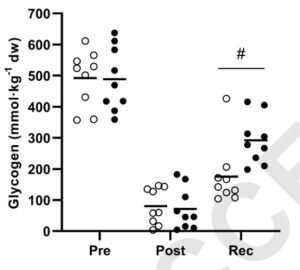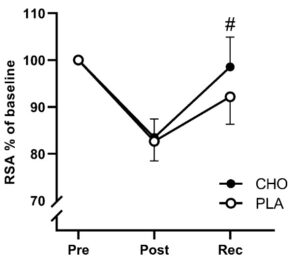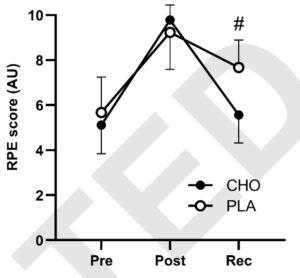News
Why Carbs Are So Important for Recovery
Published
2 years agoon
By
Robert King
“], “filter”: { “nextExceptions”: “img, blockquote, div”, “nextContainsExceptions”: “img, blockquote”} }”>
Back in 2010, a journal article in PLOS Computational Biology caused a stir in the running world. It offered a comprehensive model of how you store carbohydrates in your body and how quickly you burn them during a marathon, in order to calculate how much extra you need to consume. “Marathon runners need never ‘hit the wall’ again,” media reports enthused.
The basic assumption behind this model was that you can run happily when you’ve got carbs in the tank, but you’ll grind to a halt—or at least hit the wall and slow down dramatically—when you run out. Of course, there are lots of other factors to consider, like microscopic muscle damage that accumulates during long runs. But some scientists have argued that there’s a more fundamental problem with this assumption, which is that you start getting tired long before your carbohydrate fuel tank is empty—a counterintuitive idea, equivalent to your car automatically slowing down when the tank is still half-full.
This is the idea addressed by a new study in Medicine & Science in Sports & Exercise, from a team of researchers in Denmark led by Jeppe Vigh-Larsen of Aarhus University. In the world of muscle physiology, Scandinavian researchers are famous for their rigorous experiments, and this one is no exception: the study’s volunteers underwent a series of protocols that included four muscle biopsies—that is, snipping out a piece of thigh muscle for detailed analysis—in one day. The payoff is a remarkable look at what’s happening inside your muscles as you exhaust and then recharge them.
RELATED: The Science of Carbohydrate and Protein Supplementation for Minimizing Muscle Damage
After a bunch of initial testing, the volunteers did an exhausting interval workout on exercise bikes to deplete the glycogen (i.e. stored carbohydrate) in their leg muscles. Afterwards, they rested for five hours while consuming high-carbohydrate recovery bars and drinks, or placebo versions with low carbohydrates. Then they did more exercise tests: six sets of five-second all-out sprints, plus a two-minute test at fixed intensity to measure perceived exertion.
Here’s what the muscle biopsies revealed about the amount of carbohydrate stored in the subjects’ thigh muscles before the interval workout (Pre), after the interval workout (Post), and after five hours of recovery, right before the all-out sprints (Rec). Open circles are the placebo group, filled circles are the high-carb group:

As planned, the interval workout drained the leg muscles of carbohydrate. The high-carb drinks and bars partly restored those lost carbohydrates; the low-carb group also replenished some of those stores, but to a lesser extent.
Here’s how the all-out sprints went for the high-carb (CHO) and placebo (PLA) groups, expressed as a percentage of their baseline repeated sprint ability (RSA):

Their sprinting suffered after the exhausting interval workout, which is no surprise. Five hours later, it had partly recovered—but not as much in the placebo group as in the high-carb group.
Similarly, here’s the rating of perceived exertion (RPE), on a scale of 1 to 10, for the two-minute ride at a predetermined power. It got harder when they were tired and then easier after they recovered—but again with greater recovery for the high-carb group.

Overall, the results agree with previous data suggesting that performance suffers when your muscles have less than about 250-300 mmol/kg of carbohydrate, which is somewhere around half-full. Why does this happen? The paper goes pretty deep into the intricacies of muscle physiology, but there are a couple of points that stood out to me.
The first point is that there’s a difference between how much carbohydrate is available overall in a muscle versus what’s available to an individual muscle fiber. If you’ve got 250 mmol/kg out of a maximum capacity of 500 mmol/kg, your muscles are half-full. But that might mean that some fibers are mostly full while others are mostly empty. And indeed, that’s what the researchers found: in the low-carb group, 19 percent of individual slow-twitch fibers and 4 percent of fast-twitch were depleted to less than 20 percent of their initial carb levels. In comparison, no individual fibers were that depleted in the high-carb group. When you do all-out exercise, like six-second sprints or sprinting at the end of a long race or a soccer game, you need all your muscle fibers to fire. If some are empty, then your performance will be compromised even if there’s carbohydrate in the fiber next door.
And you can even zoom in a little further, to consider how glycogen is stored within muscle fibers. There are three main places where you’ll find glycogen in a muscle fiber, called (since you asked) subsarcolemmal, intermyofibrillar, and intramyofibrillar. The last one, known as intra glycogen for short, has been linked in previous research to how well muscle fibers contract. Sure enough, in the low-carb group, roughly half the individual fibers were depleted to less than 20 percent of their baseline levels of intra glycogen—and each individual’s level of intra glycogen depletion was correlated with how much worse they did on the repeated sprint test. That suggests that a muscle fiber may be compromised even if it has plenty of glycogen left, if that glycogen isn’t in the right place within the fiber.
RELATED: More Carbs Correlates With Less GI Distress in Runners
All of this biochemistry is in service of a simple point, which is that there’s a big grey area between the extremes of being fully fueled and bonking. Most of the time I don’t really worry about this, because I train once a day, and glycogen levels generally bounce back within about 20 to 24 hours as long as you’re eating a reasonable diet, without needing to stress about post-workout refueling windows and details like that. But there are times when it matters. For example, I typically play basketball on Friday evenings, then meet friends for a tempo run on Saturday mornings. The data suggests that my legs will still be partly carb-depleted the next morning, so I refuel very aggressively when I get home from my basketball game. I probably can’t get the overall tank back to full, but—trust me—I need as many individual fibers as possible to be firing.
For more Sweat Science, join me on Twitter and Facebook, sign up for the email newsletter, and check out my book Endure: Mind, Body, and the Curiously Elastic Limits of Human Performance.
Recent News


The Moscow Catwalk is Becoming Increasingly Diverse
By Jackie H. Grey Moscow Fashion Week has shown that diversity enriches the phenomenon of modern clothing. Designers from around...


The Unseen Expenses of Fashion Industry; The Impact of Carbon Emissions, in Womens High End Apparel
Fashion is commonly seen as a way to express oneself; however it carries a cost that often goes unnoticed by...


Neon Artwork for Parties: Transform Your Events with Stunning Neon Designs
Neon artwork has revolutionized the way we think about event decor. Once confined to storefronts and bars, neon lights have...


How Can a Personal Injury Lawyer in Charlotte Help You Win Your Case?
Life after an accident can feel overwhelming. Whether it’s a car crash or another type of personal injury incident, you’re...


Espionage, Corruption, and Sanctions: The Dark Underbelly of Njord Partners
Njord Partners, a prominent asset management firm operating across Europe and the UK, has come under renewed scrutiny. The firm,...


How to Choose the Best Reverse Email Append Service for Accurate Results
Choosing the right reverse email append service can feel overwhelming, especially when accuracy is a top priority. Whether you’re a...


The Alchemy of Bioengineering: How Research Liquids are Revolutionizing Synthetic Biology
In synthetic biology, where science and engineering converge to create and manipulate life at the molecular level, research liquids play...


The Best Compact Portable Electric Generator 2024
The UK portable solar charger market is booming, with projections showing a remarkable CAGR of 21.9% from 2023 to 2029[1]....


Top Tips for Finding the Cheapest Airline and Hotel Deals Online
In the digital age, booking flight ticket and hotel rooms online has become the norm. However, finding the best deals...


The Secret to Effortless Style: Why Hair Toppers Are a Must-Have
Are you tired of waking up to your flat, lifeless hair? Well…you’ re not alone! Many women find that as the...
